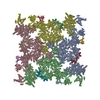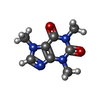+ Open data
Open data
- Basic information
Basic information
| Entry | Database: PDB / ID: 8xlf | ||||||||||||
|---|---|---|---|---|---|---|---|---|---|---|---|---|---|
| Title | Structure of chimeric RyR | ||||||||||||
 Components Components |
| ||||||||||||
 Keywords Keywords | MEMBRANE PROTEIN / Ryanodine receptor / Ion channel | ||||||||||||
| Function / homology |  Function and homology information Function and homology informationATP-gated ion channel activity / positive regulation of sequestering of calcium ion / negative regulation of calcium-mediated signaling / negative regulation of insulin secretion involved in cellular response to glucose stimulus / neuronal action potential propagation / negative regulation of release of sequestered calcium ion into cytosol / insulin secretion involved in cellular response to glucose stimulus / terminal cisterna / ryanodine receptor complex / ryanodine-sensitive calcium-release channel activity ...ATP-gated ion channel activity / positive regulation of sequestering of calcium ion / negative regulation of calcium-mediated signaling / negative regulation of insulin secretion involved in cellular response to glucose stimulus / neuronal action potential propagation / negative regulation of release of sequestered calcium ion into cytosol / insulin secretion involved in cellular response to glucose stimulus / terminal cisterna / ryanodine receptor complex / ryanodine-sensitive calcium-release channel activity / CaM pathway / Cam-PDE 1 activation / Sodium/Calcium exchangers / response to redox state / release of sequestered calcium ion into cytosol by sarcoplasmic reticulum / Calmodulin induced events / ossification involved in bone maturation / Reduction of cytosolic Ca++ levels / Activation of Ca-permeable Kainate Receptor / CREB1 phosphorylation through the activation of CaMKII/CaMKK/CaMKIV cascasde / 'de novo' protein folding / negative regulation of heart rate / Loss of phosphorylation of MECP2 at T308 / CREB1 phosphorylation through the activation of Adenylate Cyclase / cellular response to caffeine / CaMK IV-mediated phosphorylation of CREB / PKA activation / negative regulation of high voltage-gated calcium channel activity / Glycogen breakdown (glycogenolysis) / CLEC7A (Dectin-1) induces NFAT activation / skin development / Activation of RAC1 downstream of NMDARs / negative regulation of ryanodine-sensitive calcium-release channel activity / organelle localization by membrane tethering / mitochondrion-endoplasmic reticulum membrane tethering / autophagosome membrane docking / FK506 binding / negative regulation of calcium ion export across plasma membrane / regulation of cardiac muscle cell action potential / presynaptic endocytosis / organelle membrane / Synthesis of IP3 and IP4 in the cytosol / regulation of cell communication by electrical coupling involved in cardiac conduction / Phase 0 - rapid depolarisation / calcineurin-mediated signaling / Negative regulation of NMDA receptor-mediated neuronal transmission / Unblocking of NMDA receptors, glutamate binding and activation / intracellularly gated calcium channel activity / smooth endoplasmic reticulum / RHO GTPases activate PAKs / outflow tract morphogenesis / Ion transport by P-type ATPases / Uptake and function of anthrax toxins / regulation of ryanodine-sensitive calcium-release channel activity / protein phosphatase activator activity / Long-term potentiation / smooth muscle contraction / Calcineurin activates NFAT / Regulation of MECP2 expression and activity / DARPP-32 events / catalytic complex / Smooth Muscle Contraction / detection of calcium ion / regulation of cardiac muscle contraction / toxic substance binding / RHO GTPases activate IQGAPs / regulation of cardiac muscle contraction by regulation of the release of sequestered calcium ion / T cell proliferation / striated muscle contraction / voltage-gated calcium channel activity / cellular response to interferon-beta / Protein methylation / calcium channel inhibitor activity / Activation of AMPK downstream of NMDARs / presynaptic cytosol / skeletal muscle fiber development / Ion homeostasis / regulation of release of sequestered calcium ion into cytosol by sarcoplasmic reticulum / eNOS activation / titin binding / Tetrahydrobiopterin (BH4) synthesis, recycling, salvage and regulation / sperm midpiece / regulation of calcium-mediated signaling / release of sequestered calcium ion into cytosol / voltage-gated potassium channel complex / calcium channel complex / FCERI mediated Ca+2 mobilization / substantia nigra development / sarcoplasmic reticulum membrane / muscle contraction / Ras activation upon Ca2+ influx through NMDA receptor / regulation of heart rate / FCGR3A-mediated IL10 synthesis / cellular response to calcium ion / Antigen activates B Cell Receptor (BCR) leading to generation of second messengers / calyx of Held / sarcoplasmic reticulum / adenylate cyclase activator activity / protein maturation / sarcomere Similarity search - Function | ||||||||||||
| Biological species |   Homo sapiens (human) Homo sapiens (human) | ||||||||||||
| Method | ELECTRON MICROSCOPY / single particle reconstruction / cryo EM / Resolution: 3.62 Å | ||||||||||||
 Authors Authors | Lin, L. / Wang, C. / Wang, W. / Jiang, H. / Yuchi, Z. | ||||||||||||
| Funding support |  China, 3items China, 3items
| ||||||||||||
 Citation Citation |  Journal: Nat Commun / Year: 2024 Journal: Nat Commun / Year: 2024Title: Cryo-EM structures of ryanodine receptors and diamide insecticides reveal the mechanisms of selectivity and resistance. Authors: Lianyun Lin / Changshi Wang / Wenlan Wang / Heng Jiang / Takashi Murayama / Takuya Kobayashi / Hadiatullah Hadiatullah / Yu Seby Chen / Shunfan Wu / Yiwen Wang / Henryk Korza / Yucheng Gu / ...Authors: Lianyun Lin / Changshi Wang / Wenlan Wang / Heng Jiang / Takashi Murayama / Takuya Kobayashi / Hadiatullah Hadiatullah / Yu Seby Chen / Shunfan Wu / Yiwen Wang / Henryk Korza / Yucheng Gu / Yan Zhang / Jiamu Du / Filip Van Petegem / Zhiguang Yuchi /     Abstract: The resistance of pests to common insecticides is a global issue that threatens food production worldwide. Diamide insecticides target insect ryanodine receptors (RyRs), causing uncontrolled calcium ...The resistance of pests to common insecticides is a global issue that threatens food production worldwide. Diamide insecticides target insect ryanodine receptors (RyRs), causing uncontrolled calcium release from the sarcoplasmic and endoplasmic reticulum. Despite their high potency and species selectivity, several resistance mutations have emerged. Using a chimeric RyR (chiRyR) approach and cryo-electron microscopy (cryo-EM), we investigate how insect RyRs engage two different diamide insecticides from separate families: flubendiamide, a phthalic acid derivative, and tetraniliprole, an anthranilic compound. Both compounds target the same site in the transmembrane region of the RyR, albeit with different poses, and promote channel opening through coupling with the pore-forming domain. To explore the resistance mechanisms, we also solve two cryo-EM structures of chiRyR carrying the two most common resistance mutations, I4790M and G4946E, both alone and in complex with the diamide insecticide chlorantraniliprole. The resistance mutations perturb the local structure, directly reducing the binding affinity and altering the binding pose. Our findings elucidate the mode of action of different diamide insecticides, reveal the molecular mechanism of resistance mutations, and provide important clues for the development of novel pesticides that can bypass the resistance mutations. | ||||||||||||
| History |
|
- Structure visualization
Structure visualization
| Structure viewer | Molecule:  Molmil Molmil Jmol/JSmol Jmol/JSmol |
|---|
- Downloads & links
Downloads & links
- Download
Download
| PDBx/mmCIF format |  8xlf.cif.gz 8xlf.cif.gz | 2.7 MB | Display |  PDBx/mmCIF format PDBx/mmCIF format |
|---|---|---|---|---|
| PDB format |  pdb8xlf.ent.gz pdb8xlf.ent.gz | Display |  PDB format PDB format | |
| PDBx/mmJSON format |  8xlf.json.gz 8xlf.json.gz | Tree view |  PDBx/mmJSON format PDBx/mmJSON format | |
| Others |  Other downloads Other downloads |
-Validation report
| Summary document |  8xlf_validation.pdf.gz 8xlf_validation.pdf.gz | 2.1 MB | Display |  wwPDB validaton report wwPDB validaton report |
|---|---|---|---|---|
| Full document |  8xlf_full_validation.pdf.gz 8xlf_full_validation.pdf.gz | 2.3 MB | Display | |
| Data in XML |  8xlf_validation.xml.gz 8xlf_validation.xml.gz | 393.1 KB | Display | |
| Data in CIF |  8xlf_validation.cif.gz 8xlf_validation.cif.gz | 625.7 KB | Display | |
| Arichive directory |  https://data.pdbj.org/pub/pdb/validation_reports/xl/8xlf https://data.pdbj.org/pub/pdb/validation_reports/xl/8xlf ftp://data.pdbj.org/pub/pdb/validation_reports/xl/8xlf ftp://data.pdbj.org/pub/pdb/validation_reports/xl/8xlf | HTTPS FTP |
-Related structure data
| Related structure data |  38447MC  8xjiC  8xkhC  8xlhC  8y40C C: citing same article ( M: map data used to model this data |
|---|---|
| Similar structure data | Similarity search - Function & homology  F&H Search F&H Search |
- Links
Links
- Assembly
Assembly
| Deposited unit | 
|
|---|---|
| 1 |
|
- Components
Components
-Protein , 3 types, 12 molecules ABCDLIJKHEFG
| #1: Protein | Mass: 565880.500 Da / Num. of mol.: 4 / Mutation: R4563K, F4564Y,C4657I, L4792S Source method: isolated from a genetically manipulated source Source: (gene. exp.)   Homo sapiens (human) / References: UniProt: P11716 Homo sapiens (human) / References: UniProt: P11716#2: Protein | Mass: 16491.223 Da / Num. of mol.: 4 / Mutation: E32A, E68A, E105A, E141A Source method: isolated from a genetically manipulated source Source: (gene. exp.)  Homo sapiens (human) / Gene: CALM1, CALM, CAM, CAM1 / Production host: Homo sapiens (human) / Gene: CALM1, CALM, CAM, CAM1 / Production host:  #3: Protein | Mass: 11667.305 Da / Num. of mol.: 4 Source method: isolated from a genetically manipulated source Source: (gene. exp.)  Homo sapiens (human) / Gene: FKBP1B, FKBP12.6, FKBP1L, FKBP9, OTK4 / Production host: Homo sapiens (human) / Gene: FKBP1B, FKBP12.6, FKBP1L, FKBP9, OTK4 / Production host:  |
|---|
-Non-polymers , 4 types, 16 molecules 






| #4: Chemical | ChemComp-CA / #5: Chemical | ChemComp-ZN / #6: Chemical | ChemComp-ATP / #7: Chemical | ChemComp-CFF / |
|---|
-Details
| Has ligand of interest | Y |
|---|---|
| Has protein modification | N |
-Experimental details
-Experiment
| Experiment | Method: ELECTRON MICROSCOPY |
|---|---|
| EM experiment | Aggregation state: PARTICLE / 3D reconstruction method: single particle reconstruction |
- Sample preparation
Sample preparation
| Component | Name: Chimeric RyR Ca2+/ATP/caffeine/CaM1234 / Type: COMPLEX / Entity ID: #1-#3 / Source: MULTIPLE SOURCES |
|---|---|
| Source (natural) | Organism:  |
| Source (recombinant) | Organism:  Homo sapiens (human) Homo sapiens (human) |
| Buffer solution | pH: 7.4 |
| Specimen | Embedding applied: NO / Shadowing applied: NO / Staining applied: NO / Vitrification applied: YES |
| Vitrification | Cryogen name: ETHANE |
- Electron microscopy imaging
Electron microscopy imaging
| Experimental equipment |  Model: Titan Krios / Image courtesy: FEI Company |
|---|---|
| Microscopy | Model: FEI TITAN KRIOS |
| Electron gun | Electron source:  FIELD EMISSION GUN / Accelerating voltage: 300 kV / Illumination mode: FLOOD BEAM FIELD EMISSION GUN / Accelerating voltage: 300 kV / Illumination mode: FLOOD BEAM |
| Electron lens | Mode: BRIGHT FIELD / Nominal defocus max: 2400 nm / Nominal defocus min: 1200 nm |
| Image recording | Electron dose: 50 e/Å2 / Film or detector model: GATAN K3 (6k x 4k) |
- Processing
Processing
| CTF correction | Type: PHASE FLIPPING AND AMPLITUDE CORRECTION |
|---|---|
| 3D reconstruction | Resolution: 3.62 Å / Resolution method: FSC 0.143 CUT-OFF / Num. of particles: 19505 / Symmetry type: POINT |
 Movie
Movie Controller
Controller












 PDBj
PDBj
























